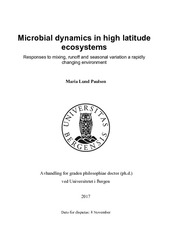Microbial dynamics in high latitude ecosystems. Responses to mixing, runoff and seasonal variation a rapidly changing environment
Doctoral thesis
Permanent lenke
https://hdl.handle.net/1956/17362Utgivelsesdato
2017-11-08Metadata
Vis full innførselSamlinger
Sammendrag
The pronounced warming at high latitude alters a range of physical conditions i.e. the magnitude of runoff, sea-ice extent and strength of stratification and thus affect the biological systems. As microorganisms form the living base of the pelagic food web and are the major drives of biogeochemical processing it is critical to understand their response to these changes. This Ph.D. project focuses on the smallest (<2μm) and most abundant microorganisms, heterotrophic bacterioplankton (bacteria and Archaea) and autotrophic picophytoplankton, and the factors regulating their abundance, diversity and activity in the Arctic-Subarctic Atlantic Ocean. The study covers hydrographic regimes off and around Iceland, Norway (including Svalbard) and East Greenland (60-83°N), and combines field observations and experiments during different seasons. The main aim is to elucidate the three following topics: 1) Challenges phytoplankton face related to high seasonality and low light conditions 2) Bioavailability of dissolved organic matter (DOM) to bacterial communities and their response to an increase in terrestrial loading 3) Importance of top-down control by heterotrophic nanoflagellates (HNF) on both pico-sized phytoplankton and bacteria. My study underpins that picophytoplankton are important contributors to primary production, especially during the winter-spring transition (Paper I and III) and autumn (Paper V). They boosted the growth of heterotrophic microorganisms before the onset of the diatom spring bloom in the Subarctic Atlantic (Paper I) and dominated the phytoplankton biomass in the high turbid parts of a NE Greenland fjord influenced by glacial meltwater (Paper V). Picophytoplankton were better adapted to low light conditions and demonstrated higher growth rates, than larger phytoplankton (Paper I, II, III, V). In the Polar-influenced water near Greenland, Synechococcus were negligible, while in the Atlantic influenced waters picoeukaryotes and Synechococcus were often equally abundant and the latter dominated on several occasions during autumn and winter (Paper I and III). Unexpectedly, abundances of Synechococcus were as high at 65°N as at 79°N, and molecular analysis suggests the presence of new clades specially adapted to Arctic conditions. Bacteria were generally rather carbon- than nutrient limited, and their abundance increased rapidly in response to the pre-bloom picophytoplankton production of labile carbon in both the Arctic and Subarctic (Paper I and V). In NE Greenland the terrestrial DOM supplied from the Greenland ice sheet proved to be highly bioavailable compared to the autochthonous fjord DOM (Paper IV). The in situ changes in DOM, which were examined via fluorescence signal of different DOM components (FDOM), surprisingly demonstrated that the highest net-growth of bacteria was not coupled to the labile glacial runoff in the surface, but rather to sub-surface the humic-DOM, commonly considered to be refractory. This may be explained by the presence of specific dominating taxa of bacteria that had the ability to degrade humic-DOM (Paper V). Across regions, HNF exerted strong control of picophytoplankton and bacteria (Paper I, II, III, V). HNF grew significantly faster than microzooplankton and were therefore less affected by mixing and relatively more important grazers than their micro-sized counterparts in well-mixed water columns (Paper I and II). HNF larger than 5μm controlled picophytoplankton particularly in the early productive season, while small HNF (3-5μm) mainly kept bacteria in check in autumn (Paper III, V). In conclusion, the studies underline that pico-sized plankton play a fundamental part in the carbon transfer in high latitude ecosystems both as primary producers and via the microbial loop. Picophytoplankton appeared better adapted than larger phytoplankton to low light conditions, and bacteria were capable of degrading terrestrial derived DOM, however, these abilities are highly community specific. The data suggest that a change in mixing patters will affect the microbial food structure and that shifts in coastal microbial community composition should be anticipated with increased runoff.
Består av
Paper I: Paulsen ML, Riisgaard K, Thingstad TF, John MS and Nielsen TG. (2015). Winter−spring transition in the subarctic Atlantic: microbial response to deep mixing and pre-bloom production. Aquat. Microb. Ecol. 76, 49–69. The article is available at: http://hdl.handle.net/1956/10971Paper II: Paulsen ML, Riisgaard K, John MS, Thingstad TF and Nielsen TG. (2017). Heterotrophic nanoflagellate grazing facilitates subarctic Atlantic spring bloom development. Aquat. Microb. Ecol. 78, 161–176. The article will be available in BORA after the publisher's embargo: http://hdl.handle.net/1956/17357. The published version is available at: https://doi.org/10.3354/ame01807
Paper III: Paulsen ML, Doré H, Garczarek L, Seuthe L, Müller O, Sandaa R-A, Bratbak G and Larsen A. (2016). Synechococcus in the Atlantic Gateway to the Arctic Ocean. Front. Mar. Sci. 3, 191. The article is available at: http://hdl.handle.net/1956/15716
Paper IV: Paulsen ML, Nielsen SEB, Müller O, Møller EF, Stedmon CA, Juul-Pedersen T, Markager S, Sejr MK, Huertas AD, Larsen A and Middelboe M. (2017). Carbon bioavailability in a high Arctic fjord influenced by glacial meltwater, NE Greenland. Front. Mar. Sci. 4, 176. The article is available at: http://hdl.handle.net/1956/17359
Paper V: Paulsen ML, Müller O, Larsen A, Møller EF, Sejr MK, Middelboe, M and Stedmon CA (2018). Biological transformation of Arctic dissolved organic matter in a NE Greenland fjord. Limnol. Oceanogr., in press. The article is available at: http://hdl.handle.net/1956/18992
